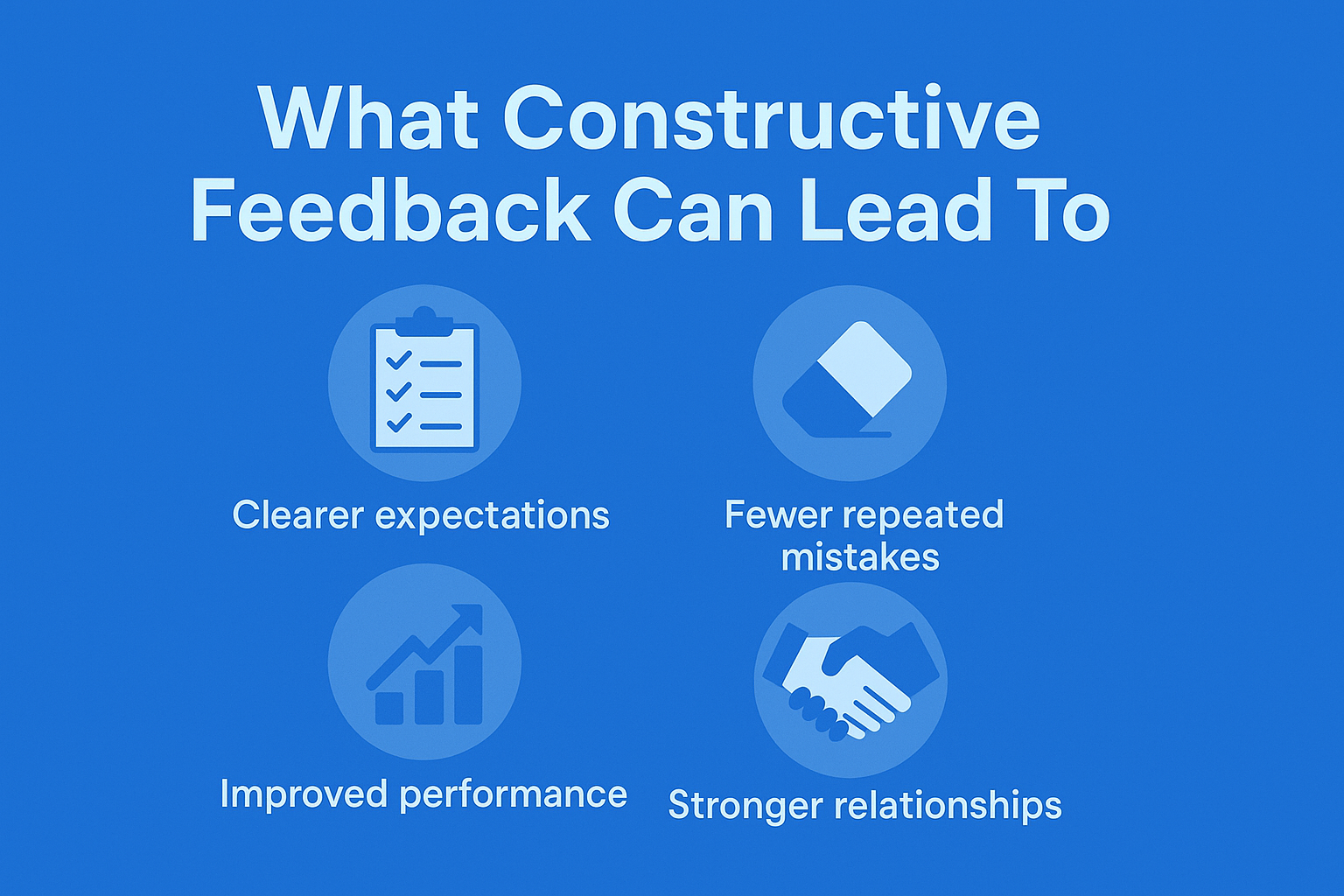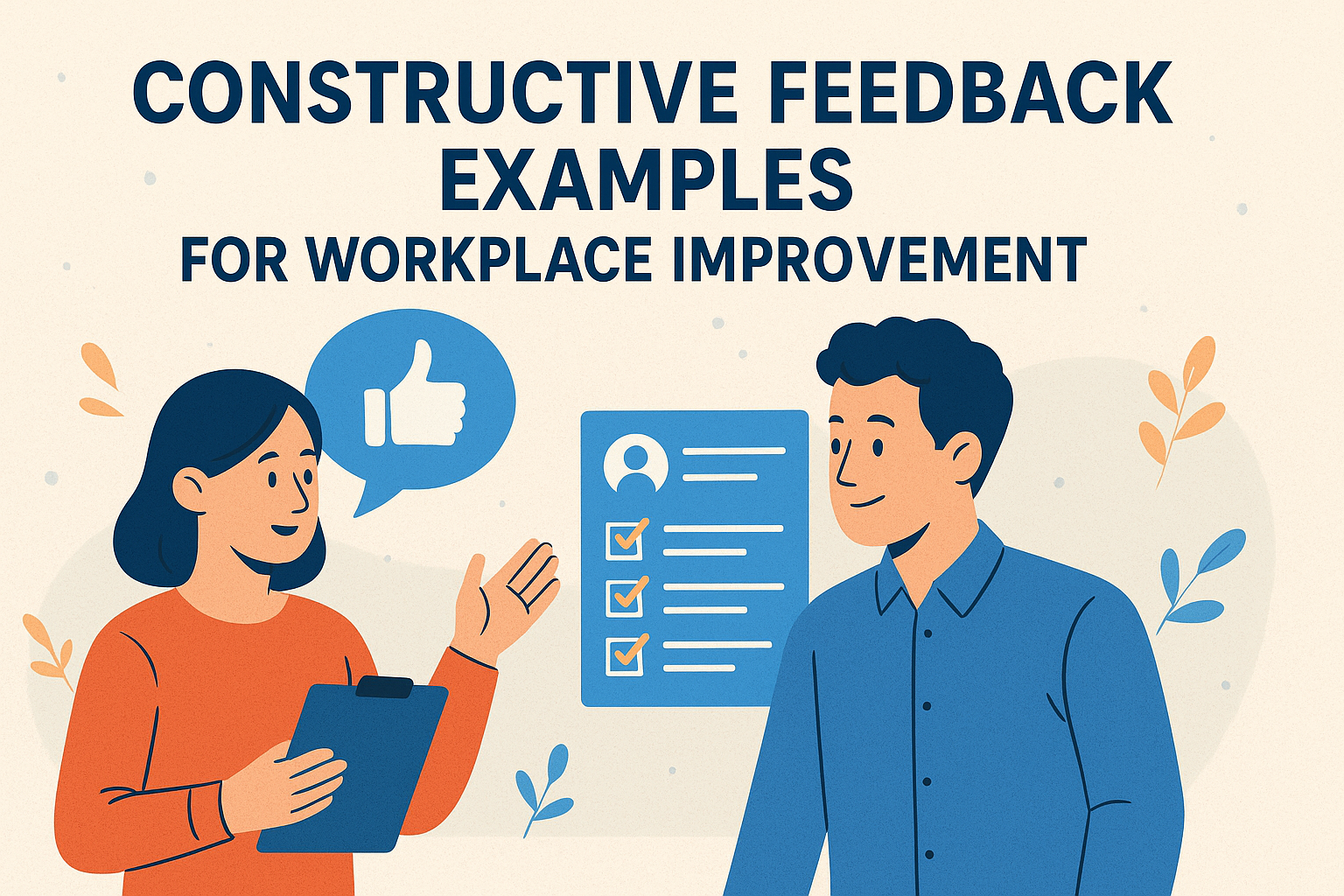Constructive feedback isn’t something people look forward to, but it’s one of the most helpful things you can give someone at work. Done right, it helps people grow, fix mistakes, and do their jobs better without making things awkward. If you’ve ever had to tell a coworker or employee something wasn’t working, you know it can be tricky. That’s why using constructive feedback the right way can make all the difference in keeping the vibe supportive, not stressful.
What Is Constructive Feedback
Constructive feedback focuses on helping someone improve instead of just pointing out what’s wrong. It doesn’t tear someone down—it builds them up with practical suggestions and a respectful tone. You’re not criticizing who someone is; you’re highlighting a behavior or result that could be better and suggesting a way forward. Think of it like a GPS recalculating a route—it’s not mad, just offering a clearer direction. In the workplace, this kind of feedback creates less tension and more trust, making people feel supported instead of judged.
What Makes Feedback Constructive
Not all feedback helps. Some just makes people defensive or confused. What sets constructive feedback apart is that it’s clear, specific, and focused on improvement. You’re not just pointing out what went wrong—you’re showing what can work better next time. Think of it like giving directions, not criticism. You’re helping someone steer toward better outcomes, not just telling them they took a wrong turn.
Why Constructive Feedback Works
You ever get told “this isn’t working” and feel stuck on what to do next? That’s what poor feedback does. But constructive feedback clears the fog. It highlights what needs fixing while giving the person a clear idea of how to move forward. It’s less about pointing fingers and more about lending a hand. It keeps teams from spinning in circles and makes sure everyone is rowing in the same direction.

How to Give Constructive Feedback Without Tension
If the idea of giving feedback makes you nervous, don’t worry—it’s normal. Here are a few simple tips that make it smoother for everyone involved:
Speak soon: Don’t let too much time pass. The closer to the moment, the better.
Stay specific: Avoid general comments like “do better.” Be clear on what happened.
Stick to actions: Keep the focus on what someone did, not who they are.
Keep it private: Unless you’re praising, save feedback for a one-on-one.
Add a next step: Feedback is more helpful with a fix, not just a flaw.
What to Avoid in Constructive Feedback
Sometimes feedback goes wrong because of how it’s delivered. Here are some habits to drop if you want your feedback to land well:
Don’t be vague: “Try harder” doesn’t help. Be clear.
No public shaming: Don’t put people on the spot in front of others.
Skip the sarcasm: It may feel funny, but it rarely helps.
Don’t pile it on: Focus on one issue at a time.
Don’t make it personal: Keep things about behavior, not attitude.
| Helpful Phrases for Constructive Feedback |
|---|
| “I noticed you’ve been… Have you thought about trying…?” |
| “One thing that could improve this is…” |
| “Let’s look at what worked and what could go better.” |
| “It might help to approach this differently by…” |
| “I think with a few adjustments, this could be stronger.” |
Constructive Feedback Examples for Work
These examples show how to give constructive feedback that supports improvement while keeping the conversation respectful, clear, and focused on growth. They help build trust, encourage accountability, and create a healthier team dynamic overall.
Missed Deadlines
“I noticed the deadline was missed for the client report. I understand that things can come up, but it’s important to keep timelines consistent. Let’s talk about what got in the way and how we can improve planning to prevent future delays.”Lack of Team Communication
“It seems like your part of the project didn’t align well with others on the team. Communication is key to making sure we’re all moving in the same direction. Can we schedule regular check-ins to stay in sync and avoid confusion?”Messy Work Presentation
“The ideas in your presentation were strong, but the structure made it hard to follow. Visual clarity plays a huge role in getting your message across. Next time, let’s work on simplifying the layout using bullet points, headers, and clean formatting.”Dominating Team Meetings
“You’ve contributed a lot of helpful ideas in our meetings, which is appreciated. However, it’s also important to give others space to share. Could we try pausing occasionally to let quieter team members speak? It’ll help make the meetings more balanced.”Not Following Instructions
“This task didn’t match the original instructions in the project brief. I know things can sometimes get lost in translation, so let’s go over the goals together. That way, we can make sure future work aligns exactly with expectations and avoids rework.”Passive Response to Issues
“I’ve noticed some challenges were left unspoken until they became bigger problems. It’s easier for us all if we raise concerns early. In the future, please feel comfortable speaking up right away so we can fix things before they escalate.”Negative Attitude
“Some of your recent comments during meetings came across as discouraging. Maintaining a positive and professional tone helps the whole team feel motivated. Let’s work on how we frame feedback so it promotes solutions and supports a more collaborative atmosphere.”Slow Response to Emails
“There’s been a noticeable delay in your replies to emails, which is affecting the team’s pace. Timely communication is really important to keep projects on track. Could we aim for responding within a specific timeframe to make sure things don’t stall?”Skipping Team Events
“I’ve noticed you haven’t been attending team events lately. While they’re not mandatory, they help build stronger team bonds. Is there something holding you back from joining? Let’s talk about what might make these events more comfortable or worthwhile for you.”Too Much Perfectionism
“Your eye for detail is a real strength, but sometimes it holds up delivery. Not every task needs to be flawless. Let’s identify which projects need polish and which ones just need to get done, so we use time more effectively.”Avoiding Responsibility
“It looked like you passed off a task that was originally yours. I know workloads can get heavy, but owning your responsibilities is part of building trust. Let’s go over what’s manageable and what support you need to handle assignments confidently.”Not Open to Feedback
“I’ve sensed some resistance when receiving feedback. It’s always meant to help, not criticize. Let’s figure out how I can deliver it in a way that feels more useful to you—maybe more one-on-one conversations or more context around why changes are needed.”Lack of Preparation
“You didn’t seem fully prepared for the client meeting, which affected how the presentation came across. Preparation shows professionalism and builds confidence. How about we make a shared prep checklist to use next time, so we’re both clear on what’s needed?”Poor Time Management
“You’ve been staying late frequently, which can be a sign that time isn’t being used efficiently during the day. I’d like to help you map out your schedule or prioritize tasks differently so you’re not burning out or falling behind.”Micromanaging
“Some teammates mentioned feeling micromanaged. I know you care about quality, but too much oversight can limit others’ growth. Could we look at assigning more ownership and trust to the team? It might help them work more independently and confidently.”

What Constructive Feedback Can Lead To
Still unsure if it’s worth giving constructive feedback regularly? Here’s what it leads to:
Clearer expectations across the team
Fewer repeated mistakes
Improved performance and job satisfaction
Stronger relationships at work
More confidence in everyone’s role
Regular feedback sets the stage for continuous learning. It creates a space where people feel safe to ask questions, take initiative, and be honest about roadblocks. Over time, this kind of environment builds momentum—not just for individuals but for entire teams. With each round of feedback, people know what’s expected and feel supported in meeting those expectations.
Using Constructive Feedback Every Day
Giving constructive feedback might feel uncomfortable at first, but it pays off. It’s not about pointing out flaws—it’s about showing people where they can shine with a few small tweaks. Use a calm tone, focus on improvement, and always speak with respect. Over time, you’ll notice a shift in how your team works, talks, and handles challenges. And that makes the workplace better for everyone.
Consistency is what turns feedback from a moment into a mindset. Don’t wait for issues to pile up—make feedback a habit. The more open and useful your conversations become, the stronger your team culture will grow.




